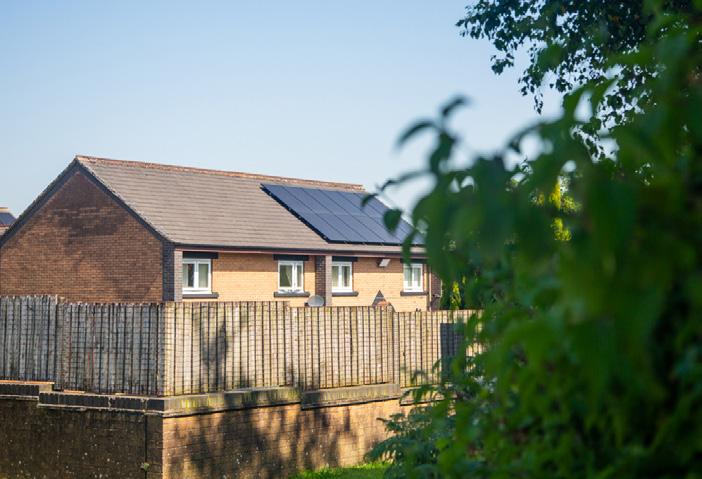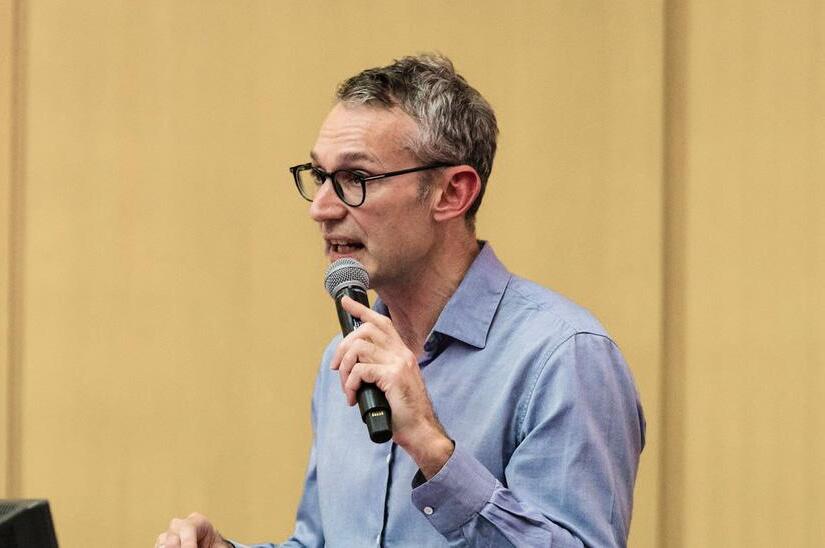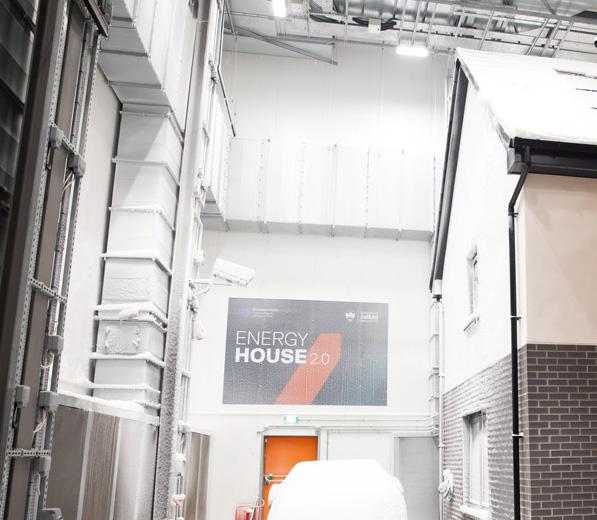Uncovering the Largest Passivhaus Project in the North West

March Edition PAGE 16
ISSUE 15 HOUSING INDUSTRY LEADERS eMAGAZINE







2 04 12 Nottingham Trent University’s Role in Sustainable Construction 20 26 Public Sector Round Up ISSUE 15 Uncovering the Largest Passivhaus Project in the North West 16 22 Energy House 2.0: Turbocharging R&D in the Social Housing Sector The Role of Full Fibre Infrastructure in Digital Inclusion 08 Overcoming Retrofitting Challenges Through Data Analytics The Safeguarding Peer Support Group: How Collaboration Protects Tenants
 Floyd March Editor
f.march@peloton-events.co.uk
Olivia Staveley Graphic Designer
Floyd March Editor
f.march@peloton-events.co.uk
Olivia Staveley Graphic Designer
FOREWORD
As we inch closer to net zero targets, new policy announcements and industry reports offer opportunities and insights for housebuilders and tenants alike.
In this issue of the Housing Industry Leaders eMagazine, we go behind the scenes at the North West’s largest Passivhaus project, delve into potential of data analytics for social housing providers, and explore the University of Salford’s Energy House 2.0 and its role in advancing innovation.
With key insights from industry professionals and experts, Housing Industry Leaders unpacks the pressing issues at the forefront of the housing sector.
“It’s a key priority for us as a housing provider to make sure that we are providing properties which support our customers.”
IN THIS ISSUE
3
Chelsea Bailey Multi Media Journalist
HIL
Hannah Wintle Multi Media Journalist
Overcoming Retrofitting Challenges Through Data Analytics
For social housing providers, the need to improve existing homes to tackle building safety issues, damp and mould, plus the current energy crisis, has never been greater. To do this, they need to have a clear understanding of their housing stock and how they can decarbonise it.

Leveraging technological advancements, such as data analytics could facilitate more informed decision-making and help to improve the retrofitting process in social housing.
By harnessing the power of data, housing providers can gain valuable insights into the condition of their properties, identify areas of inefficiency, and prioritise retrofitting efforts where they are needed the most.
THE PORTFOLIO PATHWAY SOLUTION IS ENABLING HOUSING PROVIDERS’ FORWARD PLANNING
Recognising the crucial need to decarbonise the UK’s existing housing stock, Sero’s Portfolio Pathway solution has been designed to provide social housing providers with all the management information they need to make informed decisions.
It presents a visual breakdown of costs and savings associated with each stage of the retrofit journey. This level of data offers insights into the potential effects of resident energy bills, empowering the housing providers to make data-driven decisions that optimise environmental and financial outcomes.
Anne-Marie Ratcliffe, Senior Project Manager at Sero explained that its Portfolio Pathway solution is there to support housing providers in making the best decisions: “The mix of people and software is really important to us because the expertise that we have guides people in the right direction.”
ISSUE 15 4

“The Portfolio Pathway helps housing providers to understand the overall plan to get to net zero and the costs of those measures, and enables forward planning.”
- Anne-Marie Ratcliffe, Senior Project Manager at Sero
HOUSING PROVIDERS MUST TAKE A HOLISTIC APPROACH TO TACKLING ISSUES
Beyond the technical aspects of retrofitting, there are broader social and economic considerations at play. Lower EPC-rated houses are a huge issue, and it can cost a lot to remove damp and mould from them.
Explaining this, Anne-Marie expressed: “There are wider social costs with issues such as damp and mould. People may be missing work because they’re concerned about their homes, they could be becoming ill, or children may not be comfortable doing homework after school. The financial impact stretches further than you may think.”
Continuing, she highlighted that tackling these issues could be overcome by taking a holistic approach: “From a retrofit perspective, landlords have many competing priorities right now. If they do a whole portfolio analysis in a holistic way and feed that information into their maintenance programs, they can overcome all the problems in their projects.”
BY CHELSEA BAILEY HIL 5
To date, Sero has successfully delivered nearly the full 1000 Medium Term
Improvement Plans
By integrating data-driven insights into maintenance programmes, housing provides not only could effectively address issues but optimise outcomes for both their properties and residents.
COLLABORATIONS WILL BE CRUCIAL TO THE SUCCESS OF HOUSING RETROFIT PROJECTS
By guiding housing providers on how they can integrate data to make better decisions, Sero is helping them to create their business plans regarding retrofitting.
Anne-Marie stated: “It is all about developing partnerships. We talk housing providers through the software and explore what we think they need to do, how much it will cost them, and how it will benefit them to build their business case. Once they have that business case, and funding in place, we guide them to look at the project they want to do and look at how this can be done in the best way for their budget, homes, and residents.”
As retrofitting initiatives can be complex and resource-intensive, guiding housing providers through the process of developing business plans is crucial to the success of retrofitting efforts.
One example of how Sero is developing its partnerships is its work with Sovereign Network Group (SNG). Sero worked with SNG on its SHDF Wave 2.1 bid in 2022/23. This included undertaking extensive reviews of its housing portfolio plus the identification of homes and archetypes appropriate for the bid.
It is now the Retrofit Coordinators on SNG’s 1000-home retrofit project spanning the south of England, due for completion March 2025.
On this partnership, Anne-Marie explained how Sero undertook the reviews: “One challenge that landlords face is that they may not know what is involved in retrofitting all of their housing stock. With SNG we took all of the data that is available and put that into our dashboard. With this, we explored what was going to get these homes to net zero, what their budget was for the next couple of years, and what we could do with this set budget.”
To date, Sero has successfully delivered nearly the full 1000 Medium Term Improvement Plans, which are available via its passport dashboard.
The collaboration has now expanded and it is currently engaged in a long-term initiative aimed at providing a comprehensive Portfolio Passport analysis for SNG’s extensive housing inventory, comprising approximately 80,000 homes across the UK.

6
Through shared strategic alignment, Sero and SNG have helped to drive sustainable progress in housing development and retrofitting.
SERO CAN INFORM HOUSING PROVIDERS OF HOW MUCH RETROFITTING MAY COST
To see more retrofit projects, more support is needed. This is because retrofitting projects often require significant upfront investment.
Sero’s platform can perform cost-benefit analyses to help housing providers evaluate the financial viability of retrofitting projects.
By assessing potential energy savings, carbon emission reductions, and other benefits against the costs of implementation, it assists housing providers in prioritising and planning retrofit initiatives effectively, Anne-Marie revealed.
She said: “We are able to explore the key parameters of a home and give the social housing provider an idea of what it would cost over the next five years to retrofit it. You can break down that even further with the more information you gather on that home, and this could break costs down even more.”

In addition, the platform utilises data analytics found by exploring the key parameters of a home to assess the impact of retrofitting projects on energy consumption, carbon emissions, and building performance.
By collecting and analysing data from retrofitted buildings, Sero is supporting housing providers to track the effectiveness of interventions over time and make data-driven adjustments as needed.
By continuously analysing performance data, housing providers can identify areas for further improvement and fine-tune their retrofitting strategies to achieve optimal outcomes.

THE PLATFORM IS EASILY ACCESSIBLE FOR EVERY HOUSING PROVIDER
Even though more data available means the more information there is to be gathered, a lot of data isn’t a requirement, Anne-Marie explained: “To create the Portfolio Passport, we don’t actually need a lot of existing data. It is possible to develop these pathways without any digitalisation from the landlord, and the dashboard itself is not complex. The dashboard can be assessed on an internet browser.”
In situations where housing providers may not be fully digitalised, the idea of leveraging technology for portfolio management and retrofit planning might seem daunting or inaccessible.
By making it easy for users to access and navigate, Sero’s approach shows how important it is to use data to help empower housing providers to make informed decisions and optimise their retrofitting efforts effectively.
As the retrofitting landscape evolves, the integration of data analytics will continue playing a fundamental role in shaping the future of social housing, ensuring that housing providers can effectively address the challenges the sector faces.
7
The Role of Full Fibre Infrastructure in Digital Inclusion
Access to high-spread internet has become a fundamental necessity for individuals and communities worldwide. High-rise blocks of flats, also known as Multi-Dwelling Units (MDUs) often face significant challenges when it comes to digital connectivity.

8 ISSUE 15
In response to the crucial need for improved connectivity, the deployment of full fibre infrastructure in MDUs has emerged as a key solution.
By replacing outdated copper cables with fibre-optic networks, internet service providers (ISPs) can transform the way that residents access and interact with the internet.
From bridging the digital divide to fostering connected communities, the integration of full-fibre technology in MDUs represents a crucial step towards a more accessible and inclusive digital future.
PROVIDING CUSTOMERS WITH CHOICE IS KEY TO SEEING THE DEPLOYMENT OF FIBRE-OPTIC INFRASTRUCTURE
Aiming to revolutionise digital connectivity within its MDUs, VIVID has recently started a partnership with Complete Technology Group (CTG). This partnership aims to deploy full-fibre infrastructure across VIVID’s MDUs, providing residents with faster and more reliable internet access than ever before.
With over 34,000 homes, including around 16,000 MDUs, VIVID recognises how important it is to enhance digital connectivity for its residents, Matt Bellamy, Head of Asset Strategy and Delivery at VIVID explained.
He said: “Digital services are becoming an increasingly key part of our lives however, often it is taken for granted that everyone has access to this and has the skills to get the benefit. The reality is that not everyone has this and there is a real risk of parts of society being disadvantaged.”
The challenge to seeing the wide-spread deployment of full fibre across MDUs comes down to multiple providers wishing to use their own infrastructure.
This means that the level of risk increases as multiple installations are requested, leading to the resource required to oversee such works when they are deployed increased too. Challenges also remain on the ongoing management of the equipment and unscheduled maintenance.
To combat this, Matt revealed that VIVID is ensuring that customer choice is a priority: “The approach we have adopted seeks to minimise the risk by allowing one installation, but at the same time not limiting choice to our customers. This is done by allowing the installation of infrastructure which allows multiple providers to connect to it. Having the confidence in the installation and the subsequent audit of work undertaken is key to what we are trying to achieve.”
By allowing multiple providers to connect to the infrastructure, it is not just minimising risk but also is empowering customers to select the ISP that best aligns with their needs and preferences.
This enhances the overall digital experience for customers, promotes market diversity, and contributes to the advancement of full fibre infrastructure.
However, this approach is not without its challenges, with enthusiasm from individual ISPs differing for this model.
On this, Matt stated it became apparent that there was a disconnect between granting agreements to ISPs for installations, and the actual implementation of these services.
He said: “It is clear that whilst we share a number of goals with ISPs, in providing access to digital services, there are some goals which are not immediately compatible. However, as a landlord, we need to put control and safety of installations ahead of some of the commercial interests of ISPs.”
VIVID IS RAISING AWARENESS OF THE AVAILABLE RESOURCES AND TRAINING
Funding initiatives such as the UK Government’s Project Gigabit highlight the value placed on digital inclusion. On this, Matt emphasised the importance of ensuring that funding initiatives like this don’t go to waste, highlighting VIVID’s dedication to empowering individuals to access and benefit from technology.
He said: “As technology continues to evolve, the journey towards digital inclusion needs to see a concerted effort to empower individuals and foster a more connected and inclusive society.”
9
BAILEY HIL
BY CHELSEA


To ensure funding isn’t going to waste and that people are brought on the journey, VIVID is supporting its customers through Digital Inclusion Officers. These work as part of a wider Employment, Training and Digital Inclusion Team.
Combating the challenge that lies in encouraging people to actually utilise technology, Matt explained that this role is essential in serving its customers: “Many individuals we engage with seem genuinely uncertain about where to begin. Fortunately, we have dedicated staff who excel at guiding and supporting customers through complex situations, helping to raise awareness of available resources and motivating them to acquire new skills to access them.”
VIVID’s Digital Inclusion Officers look at how it can help its customers get on line through signposting them to more cost-effective options, and by providing/signposting to training to upskill people to be more confident using the technology.
“Building strong and positive relationships with the different stakeholders involved in this is key to full fibre infrastructure in MDUs being delivered successfully.”
- Matt Bellamy, Head of Asset Strategy and Delivery at VIVID
10
By guiding customers towards more costeffective internet options and providing training to enhance their digital skills, it is helping to address barriers to access and bridge the digital divide.
BEING OPEN TO CHANGING DIGITAL TRENDS WILL HELP TO MAKE TECHNOLOGY ACCESSIBLE
Building confidence in technology usage is paramount, especially considering the generational differences that exist in communities.
Matt said that not everyone has to use technology on a day to day basis: “Going forward, we anticipate that technology will become an expected part of daily life for people. There are people out there who don’t understand technology, particularly those of a certain age, or those whose jobs are not exposed to it. So we are striving to make technology accessible to all.”
Fostering digital inclusion will be fundamental in cultivating a more connected and empowered society where everyone can thrive in a digital age.
To support seeing this digital transformation, Matt revealed that VIVID recognises that a one-size-fits-all approach won’t suffice: “Our strategy involves being vocal and demonstrating the benefits of the technology, whilst also remaining adaptable to changing trends and new technologies. We want to enhance our customers’ overall experience and ensure they benefit from all available resources.”
Being open to changing digital trends is crucial to making technology accessible as it allows organisations and individuals to adapt their approaches and offerings to align with evolving needs.
Amplying people’s overall experience with full fibre infrastructure across MDUs will be essential in not only addressing the pressing need for enhanced connectivity but also supports customers with making choices that benefit them.



11
Nottingham Trent University’s Role in Sustainable Construction
By enhancing the focus on skills, knowledge and expertise, the industry could make great steps in its journey to sustainable construction.
According to McKinsey & Company’s ‘Circularity in the Built Environment: Maximizing CO2 Abatement and Business Opportunities’ whitepaper, buildings and construction accounts for about 26% of global GHG emissions.
NOTTINGHAM TRENT UNIVERSITY IS EDUCATING STUDENTS ON THE CHANGING DEMANDS OF THE BUILT INDUSTRY
To develop skills, research, training, and consultancy to support the UK construction sector to reach its net zero target, in November 2023, Nottingham Trent University (NTU) invested £1.5 million into a new centre.
The Centre for Sustainable Construction and Retrofit has been launched to advance solutions, skills, and support locally and nationally to enable the transition to net zero within the built environment sector.
Led by Professor Richard Bull, Deputy Dean of the School of Architecture, Design and the Built Environment, the centre will bring together a range of expertise to support the sector.
Professor Bull said that in order to provide this support, the School of Architecture, Design and the Built Environment has five departments: “We are one of the largest built environment schools in terms of the numbers of students and departments, these include architecture, construction management, property management with building, surveying, civil engineering, and product design. We have four and a half students across those departments.”
“We have been working to support and create a pipeline of students who will then go on to work in the construction industry.”
Professor Richard Bull, Deputy Dean of the School of Architecture, Design and the Built Environment
The support will help to provide students with the training and opportunities needed to keep up with the changing needs of the built industry.
CONVERSATIONS AROUND SUSTAINABLE CONSTRUCTION ARE BEING ELEVATED
Alongside supporting the Dean in leading and managing the school, with a particular responsibility for the student experience, the Professor revealed that he retains a research interest in energy and sustainability in the built environment.
From this interest, he said that in past few years he has seen a shift in conversations surrounding sustainability: “Five years ago when I came to Nottingham Trent University, talking about sustainability in the built environment felt like a niche topic. Now, there is work on drafting the definition for the net zero building standards, for example.”
12 ISSUE 15


Continuing, he explained: “The sustainability piece has always been important to me, and when I arrived here, the Dean tasked me with exploring how we could build on our sustainability work.”
Sustainability work had already been key for the university, with its REMOURBAN project showing the benefits of deep retrofits.
It was showcased as part of the UK Built Environment Virtual Pavilion during COP26, and was a partnership between NTU, Nottingham City Council, Nottingham Energy Partnership, INFOHUB Ltd, and SASIE Ltd.
This work was followed by a ‘scaling-up deep retrofit for social landlords’ pilot project, which was funded by the Energy Saving Trust and ongoing collaboration with ARC Partnership and Nottingham City Council.
Work like this by the University has been essential in highlighting the importance of retrofitting in order to reach our net zero targets, and to help combat fuel poverty.
ENSURING THAT THERE WAS ONE PLACE FOR ALL CONSTRUCTION SUSTAINABILITY RESEARCH TO TAKE PLACE WAS VITAL
NTU’s record in sustainability and the built environment also includes the University’s ‘Scale-up Retrofit 2050’ whitepaper report which called for a nationwide programme to boost the energy efficiency of existing homes through deep retrofit.
On this, the Professor explained that when NTU launched the Centre for Sustainable Construction and Retrofit, he reread the paper: “From rereading, there were a couple of things that stood out, such as the need for longterm thinking. We need a long-term policy approach and we need a centre for excellence to coordinate all this activity, and through the Centre, we have now formed that.”
The Centre is working to see all the activity in one place and to help combat the challenges that Nottingham currently faces.
13 BY CHELSEA BAILEY HIL
Sustainability has become such a hot topic in the construction industry, it has completely transformed in the past few years.
In Nottingham, the demand for social housing is growing, with Nottingham City Council reporting a waiting list of over 12,000 households in 2021. This situation is common all around the UK, with many local authorities revealing long waiting lists for social housing.
REGION-BASED ACTIVITY IS FUNDAMENTAL TO RETAINING LOCAL COMMUNITIES
According to research by Action on Empty Homes, almost 1,500 homes are currently sitting empty in Nottingham. The research also shows that a further 614 properties are being used as second homes in the city.
Professor Bull explained that the Centre is focusing on combating these challenges and more, but also aims to expand this by learning from other countries: “It is all about getting that critical mass of a sense of place, and to actually start to explore the issues within the region. We are very place-focused, but as Horizon 2020 is now open for bidding again, we will be looking at what we can learn from Europe.”
Creating a sense of place is key to retaining local talent and supporting local councils. It will be crucial to help amplify confidence for not just the community but for the councils.
On why it is absolutely essential to provide support to local people, Professor Bull said: “Region-based activity is important when it comes to jobs. We’d be letting future generations down if we don’t show them that there will be good paid work in the area.”
He added: “There is a lot of research around how we decarbonise buildings, but that is not
actually the problem. We know what to do with the buildings, the challenge is having the workforce.”
A PIPELINE OF FUTURE CONSTRUCTION EMPLOYEES NEED TO BE CREATED
Nottingham Trent University has been working to ensure that it is futureproofing the construction workforce.
One way it is doing this is from its partnership with Pearson to deliver its Higher National (HN) and Higher Technical Qualifications (HTQ) to students.
On the university’s work with Pearson, the Professor said: “We have launched a Level 4 Future Homes course at our centre in Mansfield. We had 20 students there last year and 20 students this year part time.”
Its Manfield Hub is a dedicated Higher Education centre which is delivering courses and training, approximately 14 miles north of Nottingham city centre.
So far, the university has invested £6.5 million in a range of specialist teaching and learning facilities that focus on supporting local people to upskill and access employment in highdemand areas.
Nottingham Trent University’s work on boosting the journey to sustainable construction via its Centre for Sustainable Construction and Retrofit, and beyond, will help to acknowledge current gaps in skills, knowledge, and expertise that need to be overcome to futureproof the construction industry.
14
“ “

15
Uncovering the Largest Passivhaus Project in the North West
The north west’s largest Passivhaus affordable housing scheme is due to open this spring in Salford, and as the Greenhaus development’s finishing touches are added, housing provider Salix Homes are looking ahead to a more sustainable future. Housing Industry Leaders were invited along to take a closer look at the energy efficiency measures incorporated into its design.
Greenhaus’s nine storeys tower over Salford’s bustling Chapel Street, opposite Salford Cathedral, offering panoramic views of Manchester and Salford’s impressive cityscape. Where it differs from its neighbours, however, is in the inherent sustainability of its design.
Built to Passivhaus Classic Certified standard and achieving an EPC rating of B, the development utilises features such as triple glazed windows, the latest insulation technology, improved ventilation and airtightness, and air source heat pumps to create a healthier living environment for tenants, with high thermal comfort and improved air quality.
The project, in partnership with Salix Homes and supported by Salford City Council, is being delivered as part of the English Cities Fund (ECF), a joint venture between Muse, Legal & General, and Homes England. The development was designed by architect Buttress and is being built by lead contractor Eric Wright Construction.
With the first residents due to move in this March, we spoke to Glenn Martin, director of
Investment, Development and Sustainability at Salix Homes, and Alison Haigh, associate at Buttress, to learn more about the development.
SALIX HOMES ARE PRIORITISING SUSTAINABLE, AFFORDABLE HOMES
As an affordable housing scheme, all of Greenhaus’s 96 one and two-bedroom homes will be available in a mix of tenures, including social rent, affordable rent, and rent to buy. Ensuring these properties are energy efficient also plays into the hand of affordability for customers, especially against the backdrop of the current and ongoing cost-of-living crisis.
“Affordability is a key priority for our customers,” Glenn explained. “It's a key priority for us as a housing provider to make sure that we are providing properties which support our customers. Obviously, the more energy efficient the property is, the less it costs to heat. But there are also wider benefits.
“This scheme will provide a better quality of air through the MVHR systems that we've got in place, the improved insulation will reduce noise transfer within the properties, so there are wider benefits on a scheme like this. And, more broadly, we've got to look to support our customers, reducing the cost-of-living.”
When it comes to delivering sustainable housing, Salix homes are keenly aware of the need to not only embark on new build schemes like Greenhaus, but also retrofit their existing stock.
16 ISSUE 15

“We’ve got to make sure we’re achieving the right standard on new build schemes.”
- Glenn Martin. Director of Investment, Development and Sustainability at Salix Homes
17 BY HANNAH WINTLE HIL
Our existing homes have got to move to net zero targets over the next 50 years or more.
- Glenn Martin. Director of Investment, Development and Sustainability
at Salix Homes
The affordable housing provider has set a goal of reaching EPC C across their entire portfolio of properties by 2030, as well as achieving 300 new homes by 2025, though Glenn highlighted the importance of building sustainably from the outset.
He said: “We've got to make sure we're not building schemes that need to be retrofit in the future, so we've got to make sure we're achieving the right standard on new build schemes, but certainly our existing homes have got to meet the Decent Homes Standard, they've got to meet subsidy, and they've got to move to net zero targets over the next 50 years or more.
“We're undertaking large scale investment supported again by funding such as the Social Housing Decarbonisation Fund and the Social Housing Quality Fund, which is supported by GMCA. That's something we're investing every year in our existing stock to maintain the Decent Homes Standard and improve the energy efficiency of all of our properties.”
POTENTIAL PLANNING AND SUPPLY CHAIN COMPLICATIONS WERE SUCCESSFULLY AVOIDED
As more Passivhaus developments emerge throughout the UK, the planning procedures currently in place may have to adapt to accommodate them. In Greenhaus’s case, Alison explained the compromises that were made to satisfy the council when delivering the scheme.
She said: “Some councils have very specific policies. Some councils like a brick return on the windows and you can see on Greenhaus’s windows, we've actually got an aluminium frame, and that is to minimise cold bridging.
We had that conversation with the planners really early on to explain why we couldn't use brick.
“We had a bit of a discussion with them and agreed that at ground floor level, where people were going to come in closest proximity with the reveals, we could have a brick reveal at that stage.
“So, it is about compromise and education, because as soon as the planners understand the reasons why you are doing these things, and it's not just for aesthetics or cheapening the project, which sometimes these things can be, they're very understanding.”
During her work on the project, Alison qualified as a Passivhaus Consultant, and was then able to educate the team in how to deliver Greenhaus most easily.
To iron out any potential problems in advance, the supply chain was involved from early in the project. Alison recounted how a small mock up, including a section of the façade with a door, was built, which could then be used to conduct air tests.
“We were able to air test things like the windows prior to them being installed, and we did find out that there were minor issues. We rectified it on one window rather than having about a thousand windows to rectify. So, I think bringing the supply chain on early and working with the contractor eradicated any problems on site.”
The development is a part of the ECF’s £1 billion, 50-acre Salford Central transformation, which is being delivered in partnership with Salford City Council, and will take the overall percentage of affordable homes delivered by ECF to 25% across the Chapel Street area of the masterplan.
18
“ “
To learn more about the development, take a look at our recent visit to Greenhaus in the video:

19
The Safeguarding Peer Support Group: How Collaboration Protects Tenants
“We believe that through collaborative efforts and working together, it has possibilities to improve
safeguarding and create safer organisational cultures.”
– Liz Turner, Organisational Safeguarding Lead, The Riverside Group
For centuries, social housing in the UK has given people the chance to live in stable, affordable homes, and in many cases, avoid a vast array of difficult living circumstances.
Highlighting the importance of social housing, the Local Government Association states: “Council housing has been essential in helping the most vulnerable in society gain access to a home and has helped to prevent homelessness.”
In housing society’s most vulnerable, the work of local authorities and housing associations extends far beyond the point of handing over the keys. Their duty of care to tenants culminates in the mandatory requirement to step in when concerning situations arise.
Liz Turner, Director of Quality and Improvement at The Riverside Group also serves as the housing association’s Organisational Safeguarding Lead. Speaking to Housing Industry Leaders, she emphasised the importance of protecting tenants, and specifically, how a collaborative approach can be utilised to fortify safeguarding practices.
RIVERSIDE HAVE CULTIVATED A ‘PERSON-CENTRED’ APPROACH TO SAFEGUARDING
As one of the UK’s leading not-for-profit social housing and regeneration organisations, Riverside own or manage over 76,000 homes throughout the UK.
The housing association is a leading provider of supported housing services, particularly for those affected by homelessness, with a track record of transforming lives and revitalising neighbourhoods dating back over 90 years.
Due to their size and reach, Liz recognises the significant role Riverside plays in their customers’ lives, and explained how the Group have shaped their services to ensure that support is available to those at risk of abuse, harm, and neglect.
“To do this, we must look out for signs and indicators. We work in a personcentred way by promoting empowerment and managing risk appropriately,” Liz explained.
“This means treating customers with dignity and respect, seeking their views, supporting them to make choices and take decisions for themselves, so they can live as independently as possible.”
Riverside’s dedicated Safeguarding Team, which Liz heads, consists of several specialist roles aimed at protecting customers, colleagues, and communities.
COLLABORATING WITH OTHER HOUSING PROVIDERS OFFERS OPPORTUNITIES TO REVIEW AND IMPROVE
In 2021, Riverside joined forces with three leading housing associations in the UK – Home Group, Peabody, and Optivo – to form the first collaborative safeguarding group of its kind in the UK, after identifying a gap in safeguarding best practice sharing in the industry.
Today, the so-called Safeguarding Peer Support Group has expanded to seven housing providers, who meet quarterly to share learning and advice.
20 ISSUE 15
 BY HANNAH WINTLE
BY HANNAH WINTLE
Liz said: “Forming a network of safeguarding professionals through partnering with other housing providers has been an incredibly positive and beneficial experience for all involved in the Safeguarding Peer Support Group.
“Meeting regularly can present a safe space to talk openly and honestly, to discuss topics, trends and concerns, and to work as a collective to find solutions that will aim to make a difference by helping people or improve ways of working.”
Through their collaboration, the partners have found assurance in the similarities between their safeguarding processes. Importantly, however, Liz noted: “Through making comparisons amongst one another and sharing best practice, it can allow for each organisation and safeguarding professional to recognise areas of improvement and the chance to act on and be held accountable for these.”
“We continue to meet to look at and analyse safeguarding information, trends, abuse types and benchmark these across other providers, while sharing our learning and supporting each other.”
Through their continued combined efforts and quarterly meetings, members of the collaboration are able to report back to their respective Boards and Committees with regular insight and overview of Safeguarding, enabling each organisation to adapt in response and ensure the safety of all of their customers in housing across the UK.
After observing their own successes through the years, the Safeguarding Peer Support Group are now keen to encourage other social housing providers to form their own collaborative safeguarding networks, with the hopes that in doing so, further opportunities are created to better understand challenges and keep those at risk safe.
21
ENERGY HOUSE 2.0: TURBOCHARGING R&D IN THE SOCIAL HOUSING SECTOR
Sustainability and technology implementation have been growing throughout the UK social housing sector but can often be siloed apart. Joining up these approaches will improve tenants’ lives and reduce the environmental impact of retrofit and new build developments.
Looking to bridge this gap, a multi-millionpound research project is working with industry to deliver energy-efficient and sustainable new and existing homes in the Greater Manchester region.
Speaking to Housing Industry Leaders, Gary Bateman, Innovation Lead at Energy Innovation Agency explained: “Future Homes is part of the National Innovation Accelerators programme, which is aimed at speeding up the growth of three innovation clusters in Greater Manchester, Glasgow, and the West Midlands, through co-creation and regional partnerships.”
As part of the Future Homes project, £3.54m has been awarded to project partners Barratt Developments, Bellway, the Energy Innovation Agency, Q-bot, RED Cooperative, RSK Environment, Saint-Gobain, The University of Manchester, and the University of Salford.
THE FUTURE HOMES PROJECTS AIM TO ACCELERATE R&D
The Future Homes project works on six separate work packages, and the Energy House 2.0 site will be implemented throughout these separate packages to help create a built environment innovation ecosystem.
“
Achieving net zero solutions will require a deeper understanding of the whole product lifecycle to design systems that avoid unintended consequences.
“
22 ISSUE 15
In the first packages, innovators can access academic expertise and the unique facilities at the University of Salford Energy House Labs to test and verify their technologies. The aim is to support innovative products at Technology Readiness Levels 4-6 and accelerate their development and progress towards market launch.
RSK Environment will play a key role in this Work Package by building ‘digital twins’ of the Barratt Developments/Saint-Gobain and Bellway houses that are currently in Energy House 2.0.
Housing Industry Leaders heard: “This will allow a rapid evaluation of the energy/carbon saving potential of any new technology, and allow calibration of the digital energy models with the Energy House 2.0 test results.”

ENERGY HOUSE 2.0 IS A GROUNDBREAKING TESTING FACILITY
The second package runs parallel to the first one and is purely focused on the retrofit technologies in development. Having new build and retrofit coupled together in the same package like this adds a new dimension, and helps bridge the gap between the siloed focus the sector is currently seeing.
On this, Gary said: “The Energy House facilities are designed for businesses and

companies that have new low-carbon tech to do R&D with the technical teams based here, on a funded or commercial basis. We have insulation, glazing, radiators, new boilers, renewables, solar panels, and more all being brought together under one roof.”
It’s almost impossible to talk about retrofit and new build without thinking about digital delivery and how we interweave it throughout decision-making.
A spokesperson at The University of Salford explained that: “Q-bot and Red are leading this Work Package to develop a rapid digital assessment tool for retrofit. Using a suite of data input sources such as historical energy performance, geographical location, building type, physical surveys, etc, the aim is to develop a user-friendly app that provides an integrated retrofit solution for any household.”
23 BY FLOYD MARCH HIL
©McCoy_Wynne-4225
©McCoy_Wynne-4225
We’ve had some fantastic companies that have gone on to sell their technology into social housing.
“ “
MATERIAL SUSTAINABILITY MUSTN’T GO UNNOTICED
Issues with embedded carbon have also begun to dominate conversations and action plans to enhance carbon savings in the built environment are being implemented. Being able to test these products and potential solutions in the Energy House 2.0 with the vast array of climate conditions is a huge step in bringing innovative solutions to market.

Ensuring companies are working collaboratively and best practices are being shared amongst people that may not normally interact: “The Energy Innovation Agency will work with small and medium-sized businesses to accelerate product development by providing a roadmap to commercialisation.”
ENERGY INNOVATION AGENCY HAVE COLLABORATION AT THEIR CORE
This includes in-depth advice and support on key issues such as funding, investment, sales, and marketing. This Work Package will also link innovators with the technical support and facilities available in Work Packages 1, 2, and 4. Gary explained that this support, and funding from InnovateUK: “De-risks projects and gives suppliers confidence to R&D more dynamically and the energy house technicians offer advise to the companies on how to potentially improve.”
On the point of Energy House 2.0 accelerating the rollout of low-carbon technology into the social housing sector, Gary rounded up by stating: “We are accelerating the R&D of technology because we can replicate anything in the controlled environment. Instead of needing to wait months to test a solar panel in the spring or summer, we can do it over a matter of days.”
24
©McCoy_Wynne-4225
Housing Industry Leaders Upcoming

, 10:00 AM


25
Webinars
Public Sector Round Up

POLICY
Contractor Rowlinson has delivered 48 apartments and 21 houses, all available for social rent, on a brownfield site by Rochdale Canal in Newton Heath.
The 69 low-carbon homes are part of Manchester City Council’s wider ambition to build 36,000 homes by 2032, with approximately a third of those homes needing to be genuinely affordable, according to the council.
Of the 48 apartments constructed, 36 have only one bedroom while 12 have two. The city council has said it has reserved 16 apartments for those who are over the age of 55.
The apartments have been designed to HAPPI principles so that those in wheelchairs can easily navigate the space.
All homes have ground-source heat pumps and utilise mechanical ventilation with heat recovery, keeping energy costs low.
Schemes like this are needed to drive forward housing development, but also to ensure that sustainability and affordability are put at the heart of social housing projects.
PLANNING
The Pension Insurance Corporation (PIC) have invested £30 million into Apex Housing Association (Apex) to support the development of hundreds more energy efficient social homes per year.
Apex will deliver 300 to 400 new homes per year as part of their long term strategy, with all new homes to achieve a minimum EPC rating of ‘A’ from 2024.
The housing association is regulated by the Department for Communities, part of the Northern Ireland Assembly, and delivers housing of different tenures including general needs accommodation, supported housing, housing for vulnerable groups, while offering support services for tenants.
This latest investment into Apex comes after PIC completed an initial investment of £100 million in 2021.
This investment was designed to support Apex in their plans to develop 1,500 new homes, as well as helping to refinance the Apex’s existing debt. It marked the first time PIC had invested in social housing in Northern Ireland.
26 ISSUE 15

RETROFIT
Crosswind Developments has submitted a Planning Permission in Principle application to the City of Edinburgh Council to regenerate a brownfield site in west Edinburgh, as part of a £1 billion development for the city.
The developer has said its plans include a mixture of one-, two-, and three-bedroom homes, which will be designed to support affordability and intergenerational living.
Named ‘Elements Edinburgh’, the development would transform the 72-acre site situated between the established residential areas of Cammo, East Craigs, and South Gyle, and the commercial centres of Edinburgh Park and NatWest’s Gogarburn campus.
Elements Edinburgh buildings will be constructed to the highest energy-efficiency standards to lower heat demand, therefore reducing heating costs.
If realised, Elements Edinburgh could play an important role in west Edinburgh’s wider prosperity and economic growth, providing hundreds of people with high-quality, sustainable homes.
TECHNOLOGY
Bield Housing and Care has officially launched an online customer portal which is set to improve access to a range of services and encourage independent living.
As part of an ongoing commitment to digital transformation, the housing provider worked with several tenants to test a new online customer portal. Tenants involved in the trial were tasked with testing the quality and usability of the software using laptops, tablets, and smartphones.
The group also considered the functionality, design, and general use of the portal with their feedback helping to inform the final product. Following a soft launch at the end of 2023, over 170 tenants have already registered on My Bield.
The My Bield portal forms part of Bield’s strategy to enhance customer experience and diversify methods of engagement with customers.
To ensure that everyone is given the choice, staff will continue to be contactable through more traditional methods for tenants who do not want to transfer to the digital option.
27 HIL


Bringing together the Welsh Government, local authorities, housing associations, the wider stakeholder community and the supply chain
Housing Industry Leaders Cymru 2024 will bring together the Welsh Government, local authorities, housing associations, the wider stakeholder community and the supply chain to discuss their vision for the future and how the sector will support the needs of its citizens.
The event will provide a platform for current policies, plans, priorities and projects to be discussed in an open forum, discussing the challenges faced and the opportunities available in a thought provoking way.

28
July 2024
Holland House Hotel, Cardiff 28
11
Mercure





How £100 Million Will Deliver 10,000 Sustainable Homes in Wales Page 16 Also in this issue: How the Crown Estate Will Trial Zero Carbon Homes Your TSM Standard Questions Answered Issue 10 October 2023 ENHANCE YOUR KNOWLEDGE IN KEY TECHNICAL AREAS SURROUNDING THE HOUSING SECTOR IN THE UK. ISSUES Common Challenges, Shared Solutions: A Unified Approach Page 16 Also in this issue: Realising Scotland’s Housing Objectives Through Planning and Pace Openreach: Amplifying Connectivity with Full-Fibre Issue 11 November 2023 HOUSING INDUSTRY LEADERS 16 Also In This Issue: Boosting Retrofitting, Connectivity, and Engagement Page 04 Scottish Gas: Transitioning to Net-Zero One Conversation at a Time Page 20 January Edition What UK Procurement Law Shake-ups Will Mean for 2024 and Beyond ISSUE 13 Also In This Issue: Consultation Analysis: What the Good Landlord Charter Could Bring to Manchester Page 08 One-in-Four Coucils Unable to Enforce Legal Standards in Private-Rented Homes Page 12 February Edition PAGE 16 How Passivhaus Standards Are Leading the Way in Sustainable Housing Initiatives ISSUE 14 HOUSING INDUSTRY LEADERS eMAGAZINE 29

Engaging with local authorities and housing associations delivering Scotland’s housing agenda
• Housing to 2040 – setting out the vision for housing
• Affordable home supply, continuing to work closely with partners to deliver affordable homes
• Building vibrant places, helping create places people want to live, work, and bring up families
• Reducing energy consumption in the home
• How innovative thinking and new technologies will shape the future 27 November 2024


30
Radisson Blu Hotel, Glasgow








 Floyd March Editor
f.march@peloton-events.co.uk
Olivia Staveley Graphic Designer
Floyd March Editor
f.march@peloton-events.co.uk
Olivia Staveley Graphic Designer















 BY HANNAH WINTLE
BY HANNAH WINTLE

















